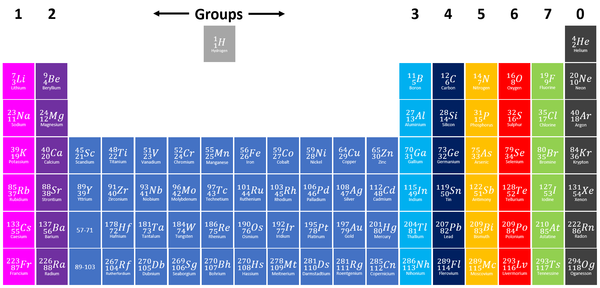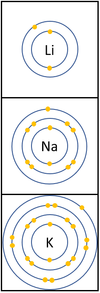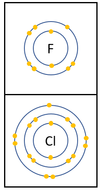Difference between revisions of "Group (Chemistry)"
| Line 55: | Line 55: | ||
: '''Alkali Metals''' are soft and can be easily cut. | : '''Alkali Metals''' are soft and can be easily cut. | ||
: '''Alkali Metals''' all appear shiny (before they [[oxidisation|oxidise]]). | : '''Alkali Metals''' all appear shiny (before they [[oxidisation|oxidise]]). | ||
| − | + | ||
| − | + | ====[[Group 7]]: The [[Halogen]]s==== | |
| − | *[[Group 0]]: The [[Noble Gases]] are all inert (unreactive). | + | =====Chemical Properties===== |
| + | : The [[reactivity]] of '''Halogens''' decreases as you go down the [[Periodic Table]]. | ||
| + | : '''Halogens''' all [[Chemical Reaction|react]] strongly as [[Bleaching Agent|bleaching agents]]. | ||
| + | : '''Halogens''' all produce [[acid]]s when combined with [[Hydrogen]]. | ||
| + | : '''Halogens''' are [[toxic]] to [[bacteria]] and are used in [[disinfectant]]s. | ||
| + | {| class="wikitable" | ||
| + | |- | ||
| + | |[[File:Group7ElectronShells.png|center|100px]] | ||
| + | | style="height:20px; width:500px; text-align:left;" |In a [[Chemical Reaction|chemical reaction]] an extra [[electron]] is added to the [[Outer Shell|outer shell]]. | ||
| + | |||
| + | The [[reactivity]] decreases as you go down the group because: | ||
| + | *The outer [[electron]]s are further away from the [[Atomic Nucleus|nucleus]] with each additional [[Electron Orbital|electron shell]] making the [[force]] of [[attract]]ion weaker. This makes it less able to gain an extra [[electron]]. | ||
| + | *Even though the [[charge]] of the [[Atomic Nucleus|nucleus]] increases the outer [[electron]]s are shielded from most of the [[Positive Charge|positive charge]] of the [[Atomic Nucleus|nucleus]] by [[electron]]s in the [[Inner Shell|inner shells]]. | ||
| + | |} | ||
| + | =====Physical Properties===== | ||
| + | The [[Physical Property|physical properties]] of '''Halogens''' changes significantly as you go down the [[Periodic Table]]: | ||
| + | *[[Fluorine]] - A yellow [[gas]] at [[Room Temperature|room temperature]]. | ||
| + | *[[Chlorine]] - A green [[gas]] at [[Room Temperature|room temperature]]. | ||
| + | *[[Bromine]] - A brown [[liquid]] at [[Room Temperature|room temperature]]. | ||
| + | *[[Iodine]] - A purple [[solid]] at [[Room Temperature|room temperature]]. | ||
| + | *[[Astatine]] -A dark purple [[solid]] at [[Room Temperature|room temperature]]. | ||
| + | : The [[density]], [[Melting Point|melting point]] and [[Boiling Point|boiling point]] all increase as you go down the [[Periodic Table]]. | ||
| + | |||
| + | ====[[Group 0]]: The [[Noble Gases]]==== | ||
| + | =====Chemical Properties===== | ||
| + | : The '''Nobel Gases''' are all [[inert]] (unreactive) because they have a full [[Outer Shell|outer shell]]. | ||
| + | |||
| + | =====Physical Properties===== | ||
| + | : The '''Nobel Gases''' are all [[gas]]es at [[Room Temperature|room temperature]]. | ||
| + | : The [[density]] and [[Boiling Point|boiling point]] all increase as you go down the [[Periodic Table]]. | ||
Revision as of 14:19, 5 December 2018
Key Stage 3
Meaning
A Group is a column on the Periodic Table with elements with the same number of electrons on the Outer Shell.
About Groups
- Helium, in Group 0 is an exception to this rule as it has 2 electrons in its Outer Shell.
- The elements are arranged groups of similar chemical properties.
- Elements have similar chemical properties when they have the same number of electrons in the Outer Shell.
Trends within groups
The chemical properties of elements within a group are similar. However, the reactivity within a group changes as you move up or down the periods.
- Group 1: The Alkali Metals all react strongly with water. The reactivity increases as you go down the group.
- Group 2: The Alkali Earth Metals all react strongly with steam and acids. The reactivity increases as you go down the group.
- Group 7: The Halogens all act as bleaching agents and kill bacteria. The reactivity decreases as you go down the group.
- Group 0: The Noble Gases are all inert (unreactive).
The physical properties of elements within a group are similar. However, the property changes gradually as you move down the group.
Key Stage 4
Meaning
A Group is a column on the Periodic Table with elements with the same number of electrons on the Outer Shell.
About Groups
- Helium, in Group 0 is an exception to this rule as it has 2 electrons in its Outer Shell.
- The elements were oringally arranged groups of similar chemical properties.
- It was later discovered that elements have similar chemical properties when they have the same number of electrons in their Outer Shells.
Trends within groups
The chemical properties of elements within a group are similar. However, the reactivity within a group changes as you move up or down the periods due to the number of Electron Shells.
Group 1: The Alkali Metal
Chemical Properties
- Alkali Metals are all highly reactive and will oxidise quickly in the presence of Oxygen.
- Alkali Metals all react strongly with water to produce metal hydroxides and Hydrogen gas.
- Alkali Metals all produce strong alkalis.
| In a chemical reaction the electron in the outer shell is lost.
The reactivity increases as you go down the group because:
|
Physical Properties
- Alkali Metals have a low density compared to other metals.
- Alkali Metals are all solid at room temperature but have a low melting point compared to other metals.
- Alkali Metals are soft and can be easily cut.
- Alkali Metals all appear shiny (before they oxidise).
Group 7: The Halogens
Chemical Properties
- The reactivity of Halogens decreases as you go down the Periodic Table.
- Halogens all react strongly as bleaching agents.
- Halogens all produce acids when combined with Hydrogen.
- Halogens are toxic to bacteria and are used in disinfectants.
| In a chemical reaction an extra electron is added to the outer shell.
The reactivity decreases as you go down the group because:
|
Physical Properties
The physical properties of Halogens changes significantly as you go down the Periodic Table:
- Fluorine - A yellow gas at room temperature.
- Chlorine - A green gas at room temperature.
- Bromine - A brown liquid at room temperature.
- Iodine - A purple solid at room temperature.
- Astatine -A dark purple solid at room temperature.
- The density, melting point and boiling point all increase as you go down the Periodic Table.
Group 0: The Noble Gases
Chemical Properties
- The Nobel Gases are all inert (unreactive) because they have a full outer shell.
Physical Properties
- The Nobel Gases are all gases at room temperature.
- The density and boiling point all increase as you go down the Periodic Table.


